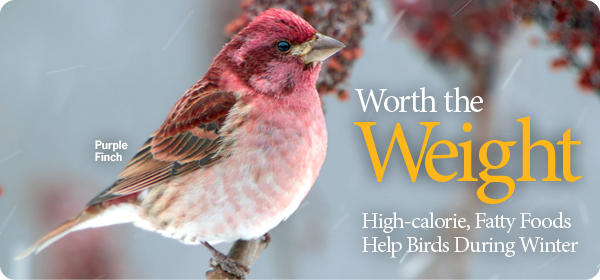Winter Guide
The life of a bird in the winter may not be as stress-free as many people think. You can help them by being seasonally savvy in winter. As winter approaches, many birds change some of their eating habits. Birds that usually eat insects may start to eat berries to supplement their diets. Birds will start to look for reliable sources of food for wintertime survival. And, in the fall, many birds begin forming flocks. Flocks of birds are better able to find food and protect themselves from predators.
In much of North America, winter can be a difficult time for birds. The days are short, and nights are often cold and long. The natural food supply has been consumed or is hidden by snow. Most insects are dead or dormant. Water can be hard to find, and food needed to provide the energy to keep birds warm might be scarce. Finding shelter may not be easy. If there are limited natural evergreens or shelter, birds may seek man-made houses or habitats that can provide refuge from the winds, rains, ice or snow of winter.
Birds are warm-blooded. In general, this means that they maintain their body temperature within a certain range even when the temperature around them changes. The maintenance of body temperature within a normal range depends on the amount of heat the bird produces.
On cold, wintry days, most birds fluff up their feathers, creating air pockets, which help keep the birds warm. The more air spaces, the better the insulation. Some birds perch on one leg, drawing the other leg to the breast for warmth.
To keep up their high metabolic rate, most backyard birds eat rich, energy foods such as seeds, insects and suet. There are some times, however, when birds are not prepared to deal with sudden drops in temperature or sudden winter storms. At times like these, it is especially helpful to have feeders full so that birds can find food easily.
Providing Food for Birds in the Winter
As winter approaches, you may need to change some of the foods you offer to birds. Providing high calorie and high fat foods can be important to the birds. The birds visiting winter feeders may be arriving in flocks or may come to the feeders as individuals, so you will need to provide different options for the birds.
Feeders should be located out of the wind. The east or southeast side of a house or near a row of trees is ideal. It is best to have a perching spot such as a bush or tree for the birds to use to survey the feeding area and provide sufficient cover for safe refuge from predators and shelter from the wind and weather. The feeders should be positioned near cover but in the open to allow birds to watch for danger. For ground feeding, an area near cover with a clear view of the surroundings is desirable.
Placing seed in a ground feeder entices birds such as sparrows, juncos, Mourning Doves, quail, pheasants, towhees and Brown Thrashers. Even the Red-bellied Woodpecker, which is thought of as a tree dweller, does some foraging on the ground. Platform and hopper feeders are especially good for attracting cardinals, wrens, chickadees, titmice, jays, and grosbeaks. Hanging feeders, because they blow in the wind, are generally used by those species that are able to hang on while feeding such as chickadees, titmice, nuthatches and finches.
Oil sunflower is a great overall seed to offer in the winter. It has a high calorie/ounce ratio due to its high fat and protein content and its relatively thin shell. Oil sunflower has twice the calories per pound than striped sunflower and its smaller shells make less mess when discarded by the birds.
Suet is a great food to offer many of the birds that will visit backyards in the winter. Suet is a high energy, pure fat substance which is invaluable in winter when insects are harder to find and birds need many more calories to keep their bodies warm.
Suet can be fed in a variety of feeders ranging from a suet cage to a wood and cage feeder offering protection from the weather elements and designed to require the birds to hang upside down.
Peanuts are another great food to offer birds in the wintertime. Peanuts have high protein and fat levels and are often an ingredient in suet products. Offering peanuts in a peanut feeder can provide a good source of protein for birds.
Providing Water for Birds
Birds do need a source for water in the winter. You can help birds find water by providing an open source of water for the birds. Bird baths can provide a water source and should be heated to help prevent the whole bath from freezing. In areas where the weather can turn cold and possibly freeze the water in bird baths, a heater or heated birdbath can keep an area open in your bird bath.
It is always a good idea to cover ceramic bird baths to keep the water out in the winter. You can put out a plastic dish with an added heater or a bird bath with a built-in heater.
Some products can be kept out all winter, if the proper bird bath de-icers are used. Check with your Wild Birds Unlimited sales associate or the manufacturer about the best kind of heaters to use in bird baths and ponds.
Providing Cover for Birds
Roosting boxes or natural plant covers can also aid birds seeking protection from cold weather. Shelter is also needed for protection against natural predators, such as birds of prey. Cats are unnatural predators and birds also need shelter to escape from them. Be sure to clean out old nests from houses to help reduce the possibility of parasitic bugs surviving the winter. It also allows birds the opportunity to roost in a clean house.


